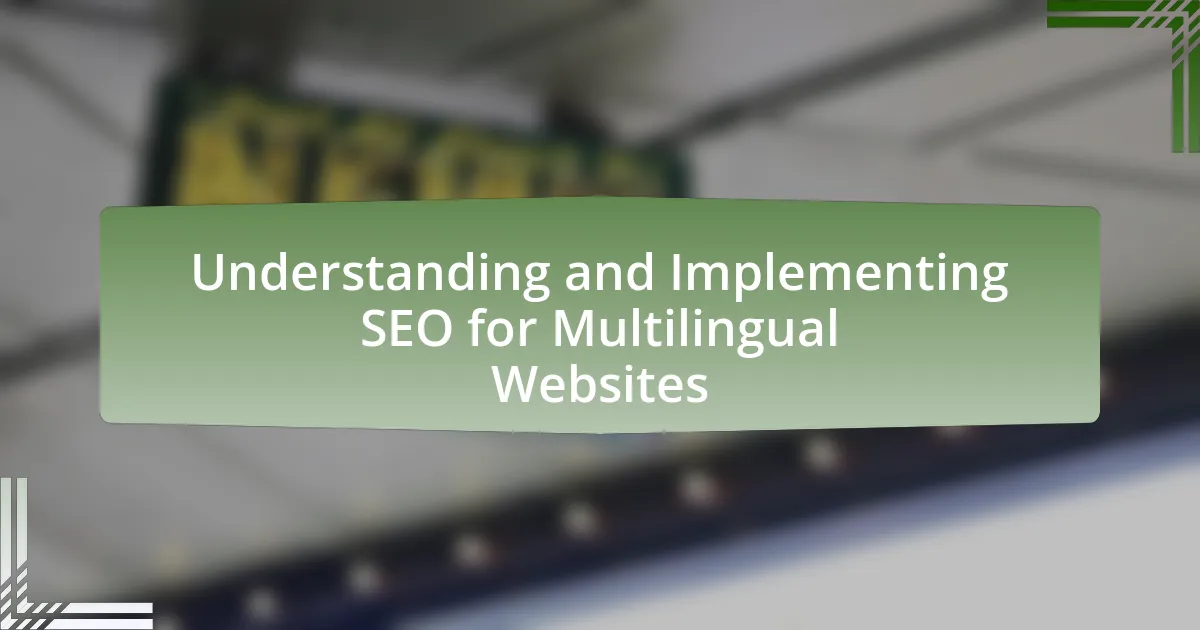SEO-friendly blog posts are articles specifically optimized to improve their ranking in search engine results, thereby increasing visibility and attracting organic traffic. Key elements of these posts include keyword optimization, quality content, proper formatting, and the use of meta tags and links. The article outlines the differences between SEO-friendly and regular blog posts, emphasizes the importance of keyword research, and discusses strategies for enhancing SEO through effective content structure and readability. Additionally, it highlights common mistakes to avoid and best practices for creating successful SEO-friendly blog posts, ultimately aiming to drive more traffic and engagement to websites.

What are SEO-Friendly Blog Posts?
SEO-friendly blog posts are articles optimized to rank higher in search engine results, thereby increasing visibility and attracting organic traffic. These posts typically incorporate relevant keywords, structured headings, and meta descriptions, which help search engines understand the content’s context. According to a study by HubSpot, blogs that are optimized for SEO can generate up to 55% more website visitors. Additionally, SEO-friendly posts often include internal and external links, enhancing user experience and credibility, which are crucial factors for search engine algorithms.
How do SEO-Friendly Blog Posts differ from regular blog posts?
SEO-friendly blog posts differ from regular blog posts primarily in their optimization for search engines. SEO-friendly posts incorporate targeted keywords, structured headings, and meta descriptions to enhance visibility in search results, while regular posts may lack these elements, focusing instead on content quality alone. Research indicates that 75% of users never scroll past the first page of search results, highlighting the importance of SEO techniques in driving traffic. Additionally, SEO-friendly posts often include internal and external links, improving site authority and user engagement, which regular posts may overlook.
What key elements define an SEO-Friendly Blog Post?
An SEO-friendly blog post is defined by several key elements: keyword optimization, quality content, proper formatting, and backlinks. Keyword optimization involves using relevant keywords strategically throughout the post, including in the title, headings, and body text, which helps search engines understand the topic. Quality content is essential; it should be informative, engaging, and provide value to readers, as search engines prioritize content that meets user intent. Proper formatting includes using headings, bullet points, and short paragraphs to enhance readability, which can reduce bounce rates. Backlinks from reputable sources improve the post’s authority and visibility in search results. These elements collectively contribute to better search engine rankings and increased organic traffic.
Why is it important to create SEO-Friendly Blog Posts?
Creating SEO-friendly blog posts is crucial because they enhance visibility in search engine results, driving organic traffic to a website. When blog posts are optimized with relevant keywords, proper formatting, and quality content, they are more likely to rank higher on search engines like Google. According to a study by HubSpot, 75% of users never scroll past the first page of search results, highlighting the importance of SEO in attracting readers. Additionally, SEO-friendly content improves user experience by providing valuable information that meets search intent, leading to higher engagement and lower bounce rates.
What are the essential components of SEO-Friendly Blog Posts?
The essential components of SEO-Friendly Blog Posts include keyword optimization, quality content, proper formatting, meta tags, and internal linking. Keyword optimization involves researching and strategically placing relevant keywords throughout the post to improve search engine visibility. Quality content must be informative, engaging, and valuable to the reader, as search engines prioritize content that meets user intent. Proper formatting, including the use of headings, bullet points, and short paragraphs, enhances readability and user experience, which can positively impact SEO rankings. Meta tags, such as title tags and meta descriptions, provide concise information about the post to search engines and users, influencing click-through rates. Internal linking connects related content within the blog, improving site navigation and helping search engines understand the structure of the website. These components collectively enhance the likelihood of higher search engine rankings and increased organic traffic.
How does keyword research contribute to SEO-Friendly Blog Posts?
Keyword research is essential for creating SEO-friendly blog posts as it identifies the terms and phrases that potential readers are searching for. By understanding these keywords, content creators can tailor their blog posts to align with user intent, increasing the likelihood of higher search engine rankings. For instance, a study by Ahrefs found that 90.63% of web pages receive no organic traffic from Google, highlighting the importance of targeting the right keywords to attract visitors. Additionally, incorporating relevant keywords into titles, headings, and throughout the content enhances visibility and relevance, making it easier for search engines to index the posts effectively.
What role does content structure play in SEO optimization?
Content structure plays a critical role in SEO optimization by enhancing readability and improving search engine indexing. A well-organized content structure, which includes the use of headings, subheadings, bullet points, and short paragraphs, allows both users and search engines to easily navigate and understand the content. Research indicates that structured content can lead to higher engagement rates, as users are more likely to stay on a page that is easy to read and comprehend. Additionally, search engines like Google prioritize content that is well-structured, as it helps them determine the relevance and context of the information presented, ultimately influencing rankings in search results.

How can you optimize your blog post for SEO?
To optimize your blog post for SEO, focus on keyword research, on-page optimization, and quality content creation. Conduct thorough keyword research to identify relevant terms that your target audience searches for, and incorporate these keywords naturally throughout your post, including in the title, headings, and meta descriptions. On-page optimization involves using proper HTML tags, optimizing images with alt text, and ensuring a mobile-friendly design. Additionally, creating high-quality, engaging content that provides value to readers can improve dwell time and reduce bounce rates, which are factors that search engines consider when ranking pages. According to a study by HubSpot, companies that prioritize blogging are 13 times more likely to see a positive ROI, highlighting the importance of effective SEO strategies in driving traffic and engagement.
What strategies can enhance the SEO of your blog post?
To enhance the SEO of your blog post, implement keyword optimization, quality content creation, and effective link building. Keyword optimization involves researching and incorporating relevant keywords into your title, headings, and throughout the content, which helps search engines understand the topic. Quality content creation focuses on providing valuable, informative, and engaging material that meets the needs of your audience, as high-quality content is favored by search engines. Effective link building includes both internal links to other relevant posts on your blog and external links to authoritative sources, which can improve credibility and search rankings. According to a study by Backlinko, pages with higher word counts tend to rank better, indicating that comprehensive content can positively impact SEO.
How do meta tags influence SEO performance?
Meta tags significantly influence SEO performance by providing search engines with essential information about a webpage’s content. Specifically, meta tags such as the title tag and meta description directly affect click-through rates from search engine results pages (SERPs). Research indicates that well-crafted meta descriptions can increase click-through rates by up to 5.8% (source: Search Engine Land, 2021). Additionally, title tags are a critical ranking factor, as they help search engines understand the relevance of a page to a user’s query. Therefore, optimizing meta tags enhances visibility and user engagement, ultimately improving overall SEO performance.
What is the significance of internal and external links?
Internal and external links are significant for enhancing SEO and improving user experience. Internal links connect different pages within the same website, helping search engines understand site structure and distribute page authority, which can lead to higher rankings. External links, on the other hand, direct users to content on other websites, establishing credibility and relevance, which search engines also consider when ranking pages. Research indicates that websites with a balanced mix of internal and external links tend to perform better in search engine results, as they provide valuable context and resources to users, thereby increasing engagement and reducing bounce rates.
How can you improve readability and engagement in your blog posts?
To improve readability and engagement in your blog posts, utilize clear and concise language, along with effective formatting techniques. Clear language enhances understanding, while formatting elements such as headings, bullet points, and short paragraphs break up text, making it easier to digest. Research indicates that readers prefer content that is visually appealing and easy to navigate; for instance, a study by the Nielsen Norman Group found that users often skim content, highlighting the importance of scannable text. Additionally, incorporating engaging elements like questions, anecdotes, or visuals can capture attention and encourage interaction, further boosting engagement.
What formatting techniques enhance user experience?
Effective formatting techniques that enhance user experience include the use of headings, bullet points, short paragraphs, and ample white space. Headings help organize content, making it easier for users to scan and locate information quickly. Bullet points break down complex information into digestible pieces, improving readability. Short paragraphs prevent overwhelming the reader and maintain engagement, while white space reduces visual clutter, allowing users to focus on the content. Research indicates that well-structured content can increase user retention and satisfaction, as users are more likely to engage with content that is easy to navigate and understand.
How does the use of images and multimedia affect SEO?
The use of images and multimedia significantly enhances SEO by improving user engagement and increasing page load times. Engaging visuals can reduce bounce rates, as users are more likely to stay on a page that contains relevant images or videos, leading to longer session durations. According to a study by HubSpot, articles with images receive 94% more views than those without. Additionally, properly optimized images with relevant alt text can improve search engine visibility, as search engines index these elements. This optimization contributes to better rankings in search results, ultimately driving more organic traffic to the website.

What are common mistakes to avoid when creating SEO-Friendly Blog Posts?
Common mistakes to avoid when creating SEO-friendly blog posts include neglecting keyword research, failing to optimize meta tags, and not using headings effectively. Neglecting keyword research can lead to targeting irrelevant terms, which diminishes visibility; studies show that 70% of online experiences begin with a search engine, emphasizing the importance of relevant keywords. Failing to optimize meta tags, such as title and description, can result in lower click-through rates, as these elements are crucial for attracting users from search results. Not using headings effectively can hinder content structure, making it difficult for both readers and search engines to understand the main topics; proper use of headings improves readability and SEO performance.
What pitfalls can hinder the SEO effectiveness of your blog posts?
Several pitfalls can hinder the SEO effectiveness of blog posts, including poor keyword optimization, lack of quality content, and inadequate internal linking. Poor keyword optimization occurs when blog posts do not effectively target relevant keywords, leading to lower visibility in search engine results. Research indicates that 70% of online experiences begin with a search engine, highlighting the importance of keyword strategy. Lack of quality content can result in high bounce rates, as users are less likely to engage with posts that do not provide valuable information. Additionally, inadequate internal linking can prevent search engines from effectively crawling and indexing a site, which can diminish overall SEO performance. According to a study by Moz, internal links help distribute page authority and improve site navigation, further emphasizing their importance in SEO.
How can keyword stuffing negatively impact your SEO?
Keyword stuffing can negatively impact your SEO by leading to penalties from search engines, which can result in lower rankings or even removal from search results. Search engines like Google prioritize user experience and relevance, and excessive keyword usage disrupts content quality, making it less readable and valuable to users. According to Google’s Webmaster Guidelines, sites that engage in manipulative practices, such as keyword stuffing, may be subject to algorithmic penalties, which can significantly decrease organic traffic.
Why is it important to avoid duplicate content?
Avoiding duplicate content is crucial for maintaining search engine optimization (SEO) effectiveness. Search engines prioritize unique content, and when multiple pages feature the same material, it can lead to lower rankings in search results. According to a study by Moz, duplicate content can dilute page authority, making it harder for search engines to determine which version to index or rank. This can result in reduced visibility and traffic to the website. Additionally, duplicate content can confuse users, leading to a poor user experience, which further impacts SEO performance.
What best practices should you follow for successful SEO-Friendly Blog Posts?
To create successful SEO-friendly blog posts, focus on keyword research, quality content, and proper formatting. Keyword research involves identifying relevant terms that your target audience searches for, which can be done using tools like Google Keyword Planner or SEMrush. Quality content should provide value, be engaging, and answer the readers’ questions, as search engines prioritize content that meets user intent. Proper formatting includes using headings, bullet points, and short paragraphs to enhance readability, which can improve user experience and reduce bounce rates. Additionally, optimizing meta tags, including title tags and meta descriptions, can significantly impact click-through rates, as these elements appear in search engine results. According to a study by HubSpot, posts that are well-structured and optimized for SEO can generate up to 55% more traffic than those that are not.
How can you effectively use analytics to refine your SEO strategy?
To effectively use analytics to refine your SEO strategy, regularly analyze key performance indicators (KPIs) such as organic traffic, bounce rates, and conversion rates. By monitoring these metrics, you can identify which keywords and content types drive the most engagement and conversions, allowing you to optimize your content accordingly. For instance, Google Analytics reports show that pages with lower bounce rates often correlate with higher rankings, indicating that user engagement is crucial for SEO success. Additionally, tools like Google Search Console provide insights into search queries that lead users to your site, enabling you to adjust your keyword strategy based on actual user behavior.
What are the benefits of regularly updating your blog content?
Regularly updating your blog content enhances search engine optimization (SEO) and improves user engagement. Fresh content signals to search engines that your site is active, which can lead to higher rankings in search results. According to a study by HubSpot, websites that regularly publish blog posts receive 97% more links to their content, indicating increased visibility and authority. Additionally, updated content can provide readers with the latest information, keeping them engaged and encouraging return visits, which further boosts site traffic and retention rates.
What practical tips can help you create SEO-Friendly Blog Posts?
To create SEO-friendly blog posts, focus on keyword research, quality content, and proper formatting. Conduct thorough keyword research to identify relevant terms that your target audience searches for, using tools like Google Keyword Planner or SEMrush. Incorporate these keywords naturally into your content, including in the title, headings, and throughout the text, ensuring a keyword density of around 1-2% for optimal results.
Quality content is essential; aim for informative, engaging, and original articles that provide value to readers. According to a study by HubSpot, companies that prioritize blogging are 13 times more likely to achieve a positive ROI. Additionally, use proper formatting techniques such as short paragraphs, bullet points, and subheadings to enhance readability and keep readers engaged.
Optimize images by using descriptive file names and alt text, which can improve search engine visibility. Finally, include internal and external links to credible sources, as this can enhance the authority of your blog post and improve its ranking on search engines.




